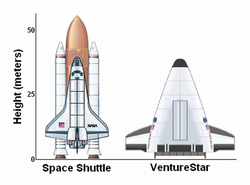VentureStar
 Simulated view of VentureStar in low Earth orbit | |
| Function | Manned Re-usable Spaceplane |
|---|---|
| Manufacturer | Lockheed Martin |
| Country of origin | United States |
| Size | |
| Height | 38.7 m[1] (127 ft) |
| Diameter | N/A |
| Mass | 1,000,000 kg[1] (2,200,000 lb) |
| Stages | 1 |
| Capacity | |
| Payload to LEO | 20,412 kg[1] (45,000 lb) |
| Launch history | |
| Status | Cancelled |
| Launch sites | Unknown |
| Total launches | 0 |
| First stage - VentureStar | |
| Engines | 7 RS2200 Linear Aerospikes[1] |
| Thrust | 3,010,000 lb[1] (13.39 MN) |
| Propellant | LOX/LH2[1] |
VentureStar was a single-stage-to-orbit reusable launch system proposed by Lockheed Martin and funded by the U.S. government. The goal was to replace the Space Shuttle by developing a re-usable spaceplane that could launch satellites into orbit at a fraction of the cost. While the requirement was for an unmanned launcher, it was expected to carry passengers as cargo. The VentureStar would have had a wingspan of 68 feet, a length of 127 feet, and would have weighed roughly 62,700 pounds.
VentureStar was intended to be a commercial single-stage-to-orbit vehicle that would launch vertically, but return to Earth as an airplane. Flights would have been leased to NASA as needed. After failures with the X-33 subscale technology demonstrator test vehicle, funding was cancelled in 2001.
Advantages over the Space Shuttle

VentureStar's engineering and design would have offered numerous advantages over the Space Shuttle, representing considerable savings in time and materials, as well as increased safety.[2] VentureStar was expected to launch satellites into orbit at about 1/10 the cost of the Shuttle.
Readying VentureStar for flight would have dramatically differed from that of the Space Shuttle. Unlike the Space Shuttle orbiter, which had to be lifted and assembled together with several other heavy components (a large external tank, plus two solid rocket boosters), VentureStar was to be simply inspected in a hangar like an aeroplane.[2]
Also unlike the Space Shuttle, VentureStar would not have relied upon solid rocket boosters, which had to be hauled out of the ocean and then refurbished after each launch.[2] Furthermore, design specifications called for the use of linear aerospike engines that maintain thrust efficiency at all altitudes. Whereas the Shuttle relied upon conventional nozzle engines which achieve maximum efficiency at only a certain altitude.[2]
VentureStar would have used a new metallic thermal protection system, safer and cheaper to maintain than the ceramic protection system used on the Space Shuttle. VentureStar's metallic heat shield would have eliminated 17,000 between-flight maintenance hours typically required to satisfactorily check (and replace if needed) the thousands of heat-resistant ceramic tiles that compose the Shuttle exterior.[2]
VentureStar was expected to be safer than most modern rockets.[2] Whereas most modern rockets fail catastrophically when an engine fails during flight, VentureStar was intended to have a thrust reserve in each engine in the event of an emergency during flight.[2] For example, if an engine on VentureStar were to have failed during an ascent to orbit, another engine opposite to the failed engine would have shut off to counterbalance the failed thrust, and each of the remaining working engines could then have throttled up so as to safely continue the mission.[2]
Unlike the Space Shuttle, whose solid rocket boosters produced chemical wastes, primarily hydrogen chloride, during launch, VentureStar's exhaust would have been composed of only water vapor, since VentureStar's main fuels would have been only liquid hydrogen and liquid oxygen.[2] This would have given VentureStar the benefit of being environmentally clean.[2] VentureStar's simpler design would have excluded hypergolic propellants and even hydraulics, relying instead upon electrical power for flight controls, doors and landing gear.[2]
Because of its lighter design, VentureStar would have been able to land at almost any major airport in an emergency,[2] whereas the Space Shuttle required much longer runways than available at most public airports.
Cancellation
The VentureStar program was cancelled due to development cost concerns accompanied by technical problems and failures in the X-33 program, a program which was intended as proof-of-concept for some of the critical technologies needed by the VentureStar. The failure during a test of the X-33's complex, multi-lobe composite-structure cryogenic hydrogen tank was one of the main reasons for the cancellation of both the X-33 and the VentureStar. Ultimately, the VentureStar program required too many technical advances at too high a cost to be viable.
In fiction
In the 2001 novella and 2015 novel Lash-Up by Larry Bond and Chris Carlson, the VentureStar prototype is converted into an armed spacecraft named Defender in order to protect US space assets from China, which is using a space gun to destroy GPS (satellite)s.[3][4]
In John Varley's novel Red Thunder and sequels, one of the major protagonists is a former VentureStar pilot.
In the television series Star Trek: Enterprise, an operational VentureStar spaceplane is included in the opening credits as part of the history of human spaceflight.[5]
See also
References
- ^ a b c d e f "AeroSpace Online:X-33 Advanced Technology Demonstrator". Retrieved 2007-04-23.
- ^ a b c d e f g h i j k l "SP-4220 Wingless Flight: The Lifting Body Story (Chapter 9)". R. Dale Reed (NASA Dryden Flight Research Center, Aerospace and Contract Engineer). NASA. August 1997. Retrieved 21 January 2010.
- ^ Bond, Larry (2001). "Lash-Up". In Coonts, Stephen (ed.). Combat. New York: Forge. pp. 149–265. ISBN 0-312-87190-2. OCLC 45066376.
- ^ Bond, Larry (2015). Lash-Up. With Chris Carlson. New York: Forge. ISBN 978-0-7653-3491-6. OCLC 906798381.
- ^ https://www.youtube.com/watch?v=ZPn-lTytfGo&feature=youtu.be&t=60
